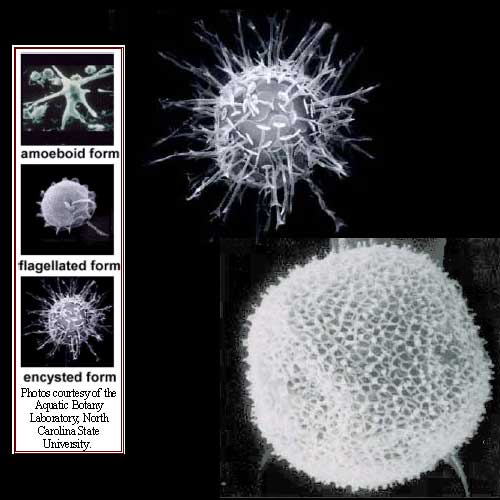- Pfiesteria
Taxobox | color = greenyellow
name = "Pfiesteria"

image_width = 240px
image_caption =
regnum =Protista
phylum =Dinoflagellata
classis =Dinophyceae
ordo =Phytodiniales
genus = "Pfiesteria"
subdivision_ranks = Species
subdivision = "Pfiesteria piscicida "
"Pfiesteria shumwayae ""Pfiesteria" is a genus of
heterotroph icdinoflagellate s that has been associated withharmful algal bloom s and fish kills. "Pfiesteria" complex organisms (PCOs) were claimed to be responsible for large fish kills in the 1980s and 1990s on the coast ofNorth Carolina and in tributaries of theChesapeake Bay . In reaction to the toxic outbreaks, six states along the US east coast initiated a monitoring program to allow for rapid response in the case of new outbreaks and to better understand the factors involved in "Pfiesteria"toxicity and outbreaks.cite journal |author=Magnien RE |title=State monitoring activities related to Pfiesteria-like organisms |journal=Environ. Health Perspect. |volume=109 Suppl 5 |issue= |pages=711–4 |year=2001 |pmid=11677180 |doi=] New molecular detection methods have revealed that "Pfiesteria" has a worldwide distribution.cite journal |author=Rublee PA, Remington DL, Schaefer EF, Marshall MM |title=Detection of the Dinozoans Pfiesteria piscicida and P. shumwayae: a review of detection methods and geographic distribution |journal=J. Eukaryot. Microbiol. |volume=52 |issue=2 |pages=83–9 |year=2005 |pmid=15817112 |doi=10.1111/j.1550-7408.2005.05202007.x]Discovery and naming
"Pfiesteria" was discovered in 1988 by
North Carolina State University researchers JoAnn Burkholder and Ed Noga. The genus was named afterLois Ann Pfiester (1936–1992), a biologist who did much of the early research on dinoflagellates. An in-depth story of the discovery can be found in "And the Waters Turned to Blood" by Rodney Barker.cite book |author=Barker, Rodney |title=And the Waters Turned to Blood |publisher=Simon & Schuster |location=New York |year= |pages= |isbn=0-684-83845-1 |oclc= |doi=]Feeding strategy
Early research resulted in the hypothesis that "Pfiesteria" acts as an "
ambush predator " and utilizes a "hit and run " feeding strategy by releasing a toxin that paralyzes the respiratory systems of susceptible fish, such asmenhaden , thus causing death bysuffocation . It then consumes the tissue sloughed off its dead prey.cite book |author=Eichhorn, Susan E.; Raven, Peter H.; Evert, Ray Franklin |title=Biology of plants |publisher=W.H. Freeman and Company |location=New York |year=2005 |pages=205 |isbn=0-7167-1007-2 |oclc= |doi=]Controversy
"Pfiesteria" biology and the role of PCOs in killing fish and causing health issues in humans have been subject to several controversies and conflicting research results over the last few years.cite web |url=http://www.vims.edu/pfiesteria/FAQ.html |title=Pfiesteria: Frequently Asked Questions |accessdate=2008-01-06 |format= |work=] cite journal |author=Miller TR, Belas R |title=Pfiesteria piscicida, P. shumwayae, and other Pfiesteria-like dinoflagellates |journal=Res. Microbiol. |volume=154 |issue=2 |pages=85–90 |year=2003 |pmid=12648722 |doi=10.1016/S0923-2508(03)00027-5]
*Life cycle: Early research suggested a complex lifecycle of "
Pfiesteria piscicida ", which has become controversial over the past few years due to conflicting research results, especially regarding the question whether toxicamoeboid forms exist or not.cite journal |author=Peglar MT, Nerad TA, Anderson OR, Gillevet PM |title=Identification of amoebae implicated in the life cycle of Pfiesteria and Pfiesteria-like dinoflagellates |journal=J. Eukaryot. Microbiol. |volume=51 |issue=5 |pages=542–52 |year=2004 |pmid=15537089|doi=10.1111/j.1550-7408.2004.tb00290.x]*Toxicity: The hypothesis of "Pfiesteria" killing fish via releasing a
toxin in the water has been questioned as no toxin could be isolated and no toxicity was observed in some experiments. Toxicity appears to depend on the strains and assays used.cite journal |author=Burkholder JM, Gordon AS, Moeller PD, "et al" |title=Demonstration of toxicity to fish and to mammalian cells by Pfiesteria species: comparison of assay methods and strains |journal=Proc. Natl. Acad. Sci. U.S.A. |volume=102 |issue=9 |pages=3471–6 |year=2005 |pmid=15728353 |doi=10.1073/pnas.0500168102] In early 2007, a highly unstable toxin produced by the toxic form of "Pfiesteria piscicida" was identified.cite journal |author=Moeller PD, Beauchesne KR, Huncik KM, Davis WC, Christopher SJ, Riggs-Gelasco P, Gelasco AK |title=Metal complexes and free radical toxins produced by Pfiesteria piscicida |journal=Environ. Sci. Technol. |volume=41 |issue=4 |pages=1166–72 |year=2007 |pmid=17598275|doi=10.1021/es0617993]*Skin lesions: The lesions observed on fish presumed killed by "Pfiesteria" have been attributed to
water mold s by some researchers. However, it has also been established that "Pfiesteria shumwayae " kills fish by feeding on their skin through micropredation.cite journal |author=Vogelbein WK, Lovko VJ, Shields JD, "et al" |title=Pfiesteria shumwayae kills fish by micropredation not exotoxin secretion |journal=Nature |volume=418 |issue=6901 |pages=967–70 |year=2002 |pmid=12198545 |doi=10.1038/nature01008]*Impact on human health: The effects of PCOs on humans have been questioned, leading to the "Pfiesteria" hysteria hypothesis." A critical review of this hypothesis in the late 1990s concluded that "Pfiesteria"-related illness was unlikely to be caused by
mass hysteria .cite journal |author=Greenberg DR, Tracy JK, Grattan LM |title=A critical review of the Pfiesteria hysteria hypothesis |journal=Md Med J |volume=47 |issue=3 |pages=133–6 |year=1998 |pmid=9601200 |doi=] This was corroborated by a later evaluation concluding that PCOs can cause human illness.cite journal |author=Collier DN, Burke WA |title=Pfiesteria complex organisms and human illness |journal=South. Med. J. |volume=95 |issue=7 |pages=720–6 |year=2002 |pmid=12144078 |doi=] The controversy about the risk of "Pfiesteria" exposure to human health is still ongoing.cite journal |author=Morris JG, Grattan LM, Wilson LA, "et al" |title=Occupational exposure to pfiesteria species in estuarine waters is not a risk factor for illness |journal=Environ. Health Perspect. |volume=114 |issue=7 |pages=1038–43 |year=2006 |pmid=16835056 |doi=] cite journal |author=Shoemaker RC, Lawson W |title=Pfiesteria in estuarine waters: the question of health risks |journal=Environ. Health Perspect. |volume=115 |issue=3 |pages=A126–7 |year=2007 |pmid=17431460 |doi=]In fiction
*A fictional "Pfiesteria" species dangerous to humans featured in
James Powlik 's 1999 environmental thriller "Sea Change".
*The fictional species "Pfiesteria homicida" was one of the antagonists inFrank Schätzing 's 2004 novel The Swarm, planned as a Hollywood movie starring Uma Thurman for release in 2010.ee also
*
Predatory dinoflagellate
*Harmful algal bloom References
Wikimedia Foundation. 2010.
